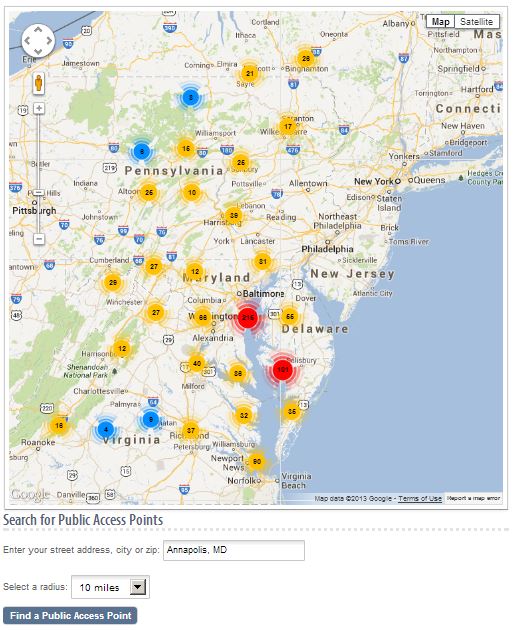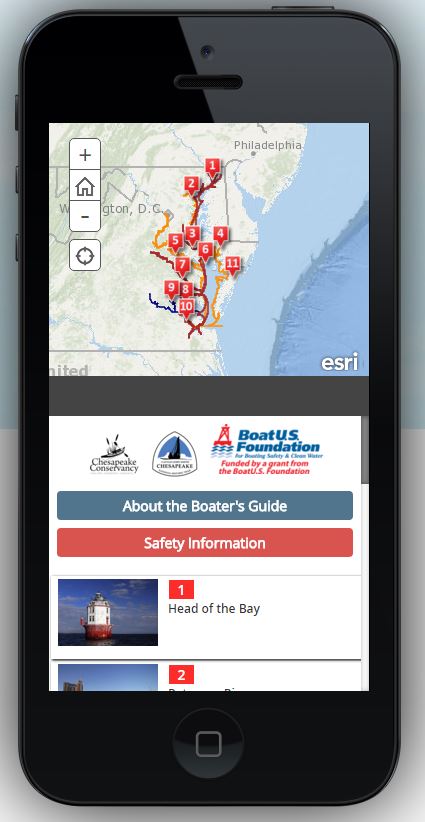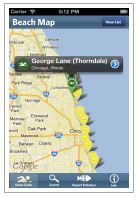There are dozens of ways to explore the Chesapeake Bay and its rivers. From mobile apps to websites to maps, here's our selection of resources to help you explore the Bay and its tributaries, paddle historic water trails, plan an excursion through history, and even find healthy beaches.
Exploring the Bay and Its Tributaries
-

Online Chesapeake Bay, Susquehanna River & Tidal Tributaries Access Guide
In 2012, 18 new public access sites opened up across the region. The Chesapeake Bay Program's online Public Access Guide provides information on over 500 major public access sites in the Bay region. Users can find sites offering opportunities for boating, fishing, wildlife observation, and beach use. Search for public access point by address, city, or zip code. Check it out at chesapeakebay.net/discover/public-access.
Water Trails
-

Captain John Smith Chesapeake National Historic Trail
Four hundred years ago Englishman John Smith set off with a small crew in an open boat to explore the Chesapeake Bay. Between 1607 and 1609 Smith mapped and documented nearly 3,000 of the Bay and its rivers. The trail, which follows his travels, was officially launched on May 12, 2007 and was the first national historic watertrail established by Congress. Visit the National Park Service's trail website at nps.gov/cajo/index.htm for information, resources, and maps.
-

- Publication
A Boater's Guide to the Captain John Smith Chesapeake National Historic Trail
This guide is a joint project of the National Park Service Chesapeake Bay Office, the Chesapeake Conservancy, and the Chesapeake Bay Foundation, and is written by CBF Senior Naturalist and Chesapeake boater extraordinaire, John Page Williams. It introduces paddlers and boaters to the best places to access the trail along with other practical information for boaters within the historical context of Captain John Smith's explorations 400 years ago. Download the guide.
-

- Mobile App & Website
Boater's Guide
Released by The Chesapeake Conservancy on the 10 year anniversary of the Trail, the app uses storymap technology from Esri to create an interactive series of maps that help users plan trips along the Trail from their computer, smartphone, or tablet. Find it at http://www.chesapeakeconservancy.org/apps/BoatersGuide/.
-

Chesapeake Bay Interpretive Buoy System
This network of observation buoys mark points along the Captain John Smith Chesapeake National Historic Trail. Just pull out your cell phone and check real-time weather and environmental information like wind speed, temperature, and wave height at any buoy location. These "smart buoys" can also tell you something about John Smith's adventures during his 1608 voyage. Enjoy exploring the Bay with the help of the Chesapeake Bay Interpretive Buoy System (CBIBS) at buoybay.noaa.gov, by phone at 877-BUOY-BAY (toll-free), or via smartphone apps for Android and iPhone.
-

Star-Spangled Banner National Historic Trail
America's second national historic watertrail, the Star-Spangled Banner trail tells the story of the Chesapeake Bay region's involvement in the War of 1812 and tells the stories of the events, people, and places that led to the birth of our National Anthem. Find out more at nps.gov/stsp/.
Safe Swimming
-

Maryland Healthy Beaches Google™ Earth Beach Notification System
Get updates, advisories, and closing information on every beach in Maryland, using the free Google™ Earth application. Go to mde.maryland.gov/programs/Water/MHB/Pages/Maryland-Healthy-Beaches-Home.aspx for easy instructions, and to download the current update file and Google Earth application.
-

Waterkeeper Swim Guide
Identify at a glance which beaches are clean for swimming and which have water quality problems, help protect your waterway by reporting pollution or environmental concerns, and more. Check it out online or get the app (available for Apple and Android).


